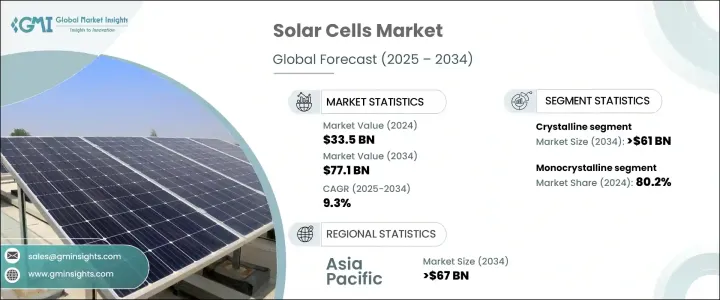
세계의 태양전지 시장은 2024년 335억 달러에 달했고, 2025년부터 2034년까지 CAGR 9.3%를 나타낼 것으로 예측됩니다.
이 시장은 기술의 진보, 생산 비용의 저하, 재생 가능 에너지 솔루션에 대한 의식 증가에 의해 견인력을 늘리고 있습니다. 태양전지 효율의 혁신과 태양에너지 시스템의 보급이 업계를 재구성하고 있습니다. 정부 지원 정책, 인터넷 미터링 우대 조치, 재생 가능 에너지 의무화는 확대를 가속화하고 있습니다. 제조 비용 저하와 경쟁 격화는 효율적인 태양광 발전 솔루션의 개발을 더욱 촉진하고 있습니다. 원격지에서의 오프 그리드 태양광 발전 용도의 채용 증가와 태양광 발전과 축전지 시스템의 통합도 시장 수요를 촉진하고 있습니다. 게다가 주거용 태양광 발전 시스템의 설치가 증가하고 있는 것도 업계의 발자취를 확대하는데 중요한 역할을 하고 있습니다.

결정계 태양전지 분야는 비용효과와 뛰어난 효율성으로 견인되어 2034년까지 610억 달러 이상에 달할 것으로 예상되고 있습니다. 패시브 이미터 및 리어 셀(PERC), 이종접합 기술(HJT), N형 실리콘 등의 첨단 기술의 도입으로 효율 수준은 더욱 향상되고, 태양광 솔루션은 다양한 용도로 보다 현실적인 것으로 되어 있습니다.
| 시장 범위 | |
|---|---|
| 시작 연도 | 2024년 |
| 예측 연도 | 2025-2034년 |
| 시작 금액 | 335억 달러 |
| 예측 금액 | 771억 달러 |
| CAGR | 9.3% |
셀 기술의 진보로 태양에너지 이용이 최적화되어 에너지 변환율이 향상되어 전자 재결합 손실이 감소하고 있습니다. 다결정, CdTe, 비정질 실리콘(A-Si), 셀렌화 구리 인듐 갈륨(CIGS) 기술도 진화하고 있어 주택, 상업, 공업의 각 분야에 있어서의 태양전지 용도의 확대에 공헌하고 있습니다.
미국의 태양전지 시장은 2022년에 8억 4,000만 달러, 2023년에 8억 8,000만 달러, 2024년에 9억 1,000만 달러를 기록했습니다. 시장 원동력은 태양광 발전소 설치가 증가해 재생가능에너지에 대한 대처가 확대되고 있는 것입니다.
아시아태평양의 태양전지 시장은 정부의 강력한 인센티브와 고효율 태양전지 기술에 대한 투자 증가에 힘입어 2034년까지 670억 달러를 넘는 것으로 예측되고 있습니다. 농촌 전기화 프로그램의 확대나, 풍력과 축전지를 통합한 하이브리드 솔라 프로젝트 시장 개척이, 시장의 성장을 한층 더 추진하고 있습니다. 동남아시아의 국가들은 태양광 발전 설비의 급증을 목표로 하고 있어, 이 지역을 세계의 태양광 발전 시장의 주요 공헌 지역으로서 자리 매김하고 있습니다.
각국이 에너지의 자립과 지속가능성의 목표 달성을 향해 임하는 가운데 태양에너지의 채용은 가속될 것으로 예상됩니다.
The Global Solar Cells Market was valued at USD 33.5 billion in 2024 and is projected to grow at a CAGR of 9.3% from 2025 to 2034. The market is gaining traction due to advancements in technology, declining production costs, and increasing awareness of renewable energy solutions. Innovations in solar cell efficiency and the widespread adoption of solar energy systems are reshaping the industry. Supportive government policies, net metering incentives, and renewable energy mandates are accelerating expansion. Lower manufacturing expenses and growing competition are further fostering the development of efficient solar power solutions. The rising adoption of off-grid solar applications in remote regions and the integration of solar power with battery storage systems are also fueling market demand. Additionally, increasing installations of residential solar power systems are playing a crucial role in expanding the industry's footprint.

The crystalline solar cells segment is anticipated to surpass USD 61 billion by 2034, driven by cost-effectiveness and superior efficiency. Monocrystalline technology is well-established, offering high-performance solar panels with efficiency rates exceeding 20%. The introduction of advanced technologies such as Passivated Emitter and Rear Cell (PERC), heterojunction technology (HJT), and N-type silicon has further enhanced efficiency levels, making solar solutions more viable for diverse applications. The growing adoption of monocrystalline panels, which accounted for 80.2% of the solar cells market in 2024, is a testament to their reliability and improved performance.
| Market Scope | |
|---|---|
| Start Year | 2024 |
| Forecast Year | 2025-2034 |
| Start Value | $33.5 Billion |
| Forecast Value | $77.1 Billion |
| CAGR | 9.3% |
Advancements in cell technology are optimizing solar energy utilization, improving energy conversion rates, and reducing electron recombination losses. Crystalline solar cells, particularly monocrystalline variants, continue to dominate the market due to their durability and superior energy output. Polycrystalline, CdTe, amorphous silicon (A-Si), and copper indium gallium selenide (CIGS) technologies are also evolving, contributing to the expansion of solar applications across residential, commercial, and industrial sectors.
The US solar cells market recorded values of USD 840 million in 2022, USD 880 million in 2023, and USD 910 million in 2024. The growth is fueled by increasing installations of solar power plants and expanding renewable energy initiatives. The country's focus on large-scale solar projects and supportive state policies is driving adoption across utility-scale, residential, and commercial installations.
The Asia Pacific solar cells market is projected to exceed USD 67 billion by 2034, supported by strong government incentives and rising investments in high-efficiency solar technology. Rapid urbanization and industrialization in emerging economies are increasing the demand for reliable and sustainable energy sources. The expansion of rural electrification programs and the development of hybrid solar projects integrating wind and battery storage are further bolstering market growth. Countries across Southeast Asia are witnessing a surge in solar installations, positioning the region as a key contributor to the global solar market.
The adoption of solar energy is expected to accelerate as nations work toward achieving energy independence and sustainability goals. With ongoing advancements in solar technology and increasing policy support, the market is poised for significant expansion in the coming years.